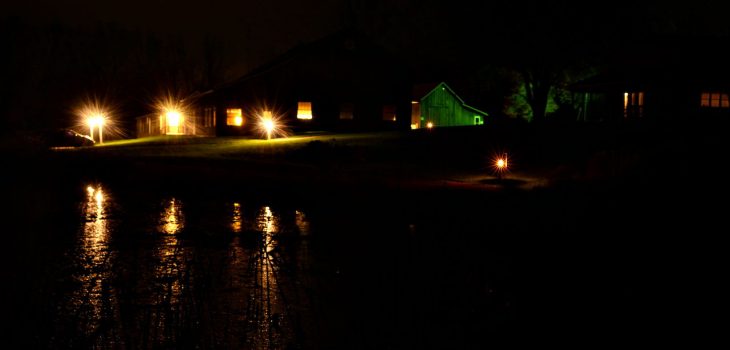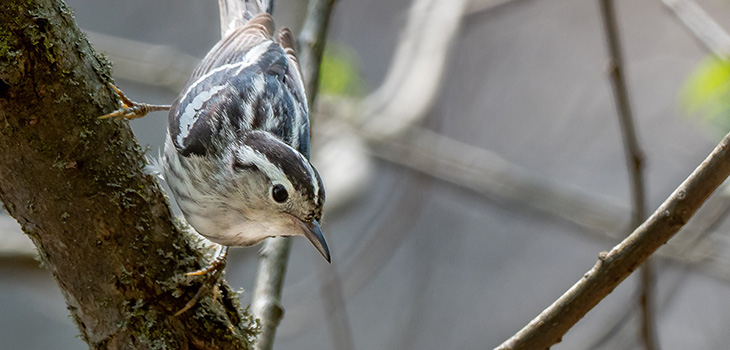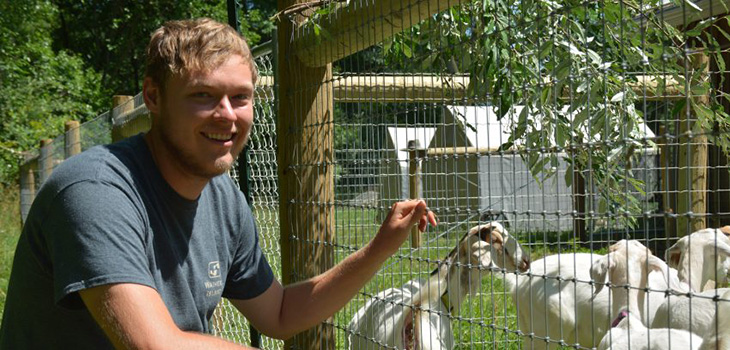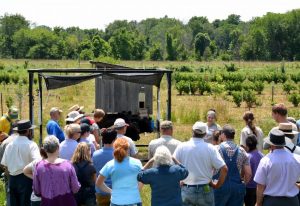 It was not your typical pasture walk. Cows, chickens, nut trees, fruit trees, grapevines and raspberries were all sharing the same five acres at the Merry Lea Sustainable Farm (MLSF), Wolf Lake, Ind.
It was not your typical pasture walk. Cows, chickens, nut trees, fruit trees, grapevines and raspberries were all sharing the same five acres at the Merry Lea Sustainable Farm (MLSF), Wolf Lake, Ind.
“How can we improve our pastures?” Ruth Mischler asked the nearly forty people who gathered for the La Grange County Soil and Water Conservation District’s (SWCD) July pasture walk. Mischler is an assistant professor in the Sustainability and Environmental Education Department at Goshen College, Goshen, Ind. with special interests in animal husbandry and cover crops.
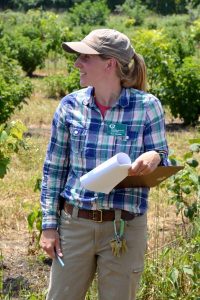 Mischler decided to host a pasture walk after attending the Northern Indiana Grazing Conference–a February event held in Shipshewanna, Ind., that draws 1500 people from as far away as Missouri. She saw it as a way to learn from other people and build relationships. She also felt that the MLSF had unique features to share.
Mischler decided to host a pasture walk after attending the Northern Indiana Grazing Conference–a February event held in Shipshewanna, Ind., that draws 1500 people from as far away as Missouri. She saw it as a way to learn from other people and build relationships. She also felt that the MLSF had unique features to share.
An educational farm
For one thing, as a farm that is an educational nonprofit, the MLSF does not need to focus only on what is most profitable. The staff has the opportunity to try out a wide variety of strategies for growing food–from beekeeping to planting okra to raising milk goats.
“Whenever we make a decision, we ask ourselves, ‘What is the educational value of this decision?’” explains Dr. John Mischler, director of the Agroecology Summer Intensive for undergraduates (ASI). The 10-week summer program is required for those studying sustainable food systems at Goshen College. Students from other schools and majors are welcome. The farm also hosts children’s school programs, and master’s students in environmental education complete practicum hours here. Through events like the pasture walk, the Mischlers take pains to make the MLSF available to the broader community.
An ecological system
Secondly, the MLSF is nestled within the context of Merry Lea Environmental Learning Center of Goshen College, an 1,189-acre nature preserve. The gardens overlook a nine-acre wetland and are edged by forest. Pollinator strips court beneficial insects and summer researchers analyze the possibility of raising beef cattle on prairie grasses. From kindergarteners to master’s students, visitors learn to think of a farm as an ecological system, not just a food factory for humans.
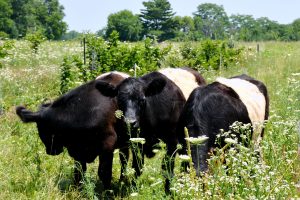 The five-acre Woody Perennial Polyculture is perhaps the farm’s most distinctive example of this paradigm shift. It was planted in 2014 as a test site for the Savanna Institute of Urbana, Ill., an organization that explores the economic and ecological viability of restoration agriculture.
The five-acre Woody Perennial Polyculture is perhaps the farm’s most distinctive example of this paradigm shift. It was planted in 2014 as a test site for the Savanna Institute of Urbana, Ill., an organization that explores the economic and ecological viability of restoration agriculture.
The WPP is an experiment in land sharing: between crops and farm animals, between human agriculture and the natural world. The mix of young nut trees, fruit trees, grape vines and brambles in the WPP mimics a savanna ecosystem. Until the trees grow large enough to block the sun, a row of asparagus is making use of available light. The uneven height of the plants allows pollinators to find their way into the field.
Animals are an important part of the system. Several Belted Galloway cattle graze between the rows of perennial crops. The black-and-white breed from Scotland produces very lean meat and does well on rough forage. They rotate through the plot with the help of portable fencing.
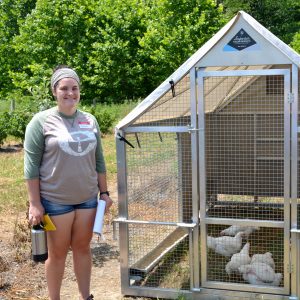 Black Australorp laying hens strut freely throughout the WPP. Red Rangers and Jumbo Cornish Crosses peck inside two portable stainless steel cages that are easy to move to fresh grazing sites. ASI students raised the meat chickens from chicks in order to compare the two varieties. Both the chickens and cattle fertilize the field with their wastes.
Black Australorp laying hens strut freely throughout the WPP. Red Rangers and Jumbo Cornish Crosses peck inside two portable stainless steel cages that are easy to move to fresh grazing sites. ASI students raised the meat chickens from chicks in order to compare the two varieties. Both the chickens and cattle fertilize the field with their wastes.
The seasoned farmers in the crowd were able to respond to Ruth Mischler’s questions from their own experiences grazing livestock. They also had questions of their own about Merry Lea’s WPP.
“Do you have depredation from wildlife?”
“Where do you get your animals butchered?”
“What is your rate of gain on the cattle?”
“Do you use any pesticide on the fruit trees?
SWCD District Manager Martin Franke says his organization has been offering pasture walks since 1999 when the USDA was emphasizing rotational grazing. Because of local interest in running small, sustainable dairy farms (many of them are Amish), the LaGrange SWCD has continued the focus.
“We come to see if someone’s doing a better job than we are,” chuckled Kathy Raub. She and her husband raise purebred Limousin beef cattle on a 40-acre farm in Hamlet, Ind.
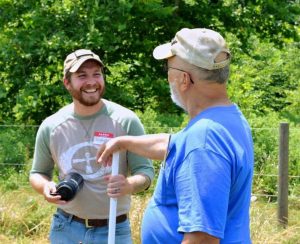 Currants were ripe at the time of the pasture walk, allowing for human grazing. Ruth reflected on the pros and cons of raising chickens and currant plants together. On the one hand, they provide free labor, turning low hanging and dropped fruit into meat. The trade-off is that they scratch at the roots of the plants, which is not ideal.
Currants were ripe at the time of the pasture walk, allowing for human grazing. Ruth reflected on the pros and cons of raising chickens and currant plants together. On the one hand, they provide free labor, turning low hanging and dropped fruit into meat. The trade-off is that they scratch at the roots of the plants, which is not ideal.
Not every farmer has time to experiment with perennial polycultures or sort out chicken dilemmas like this one. By building mutually beneficial relationships with local farmers, the MLSF team aims to hone strategies that increase the health of the land and share them.

